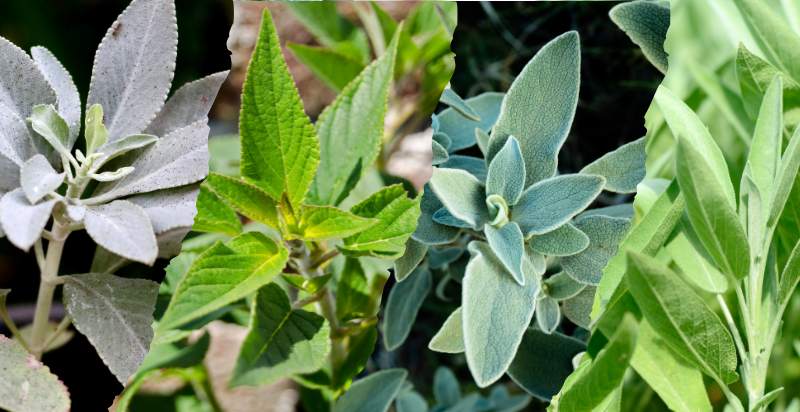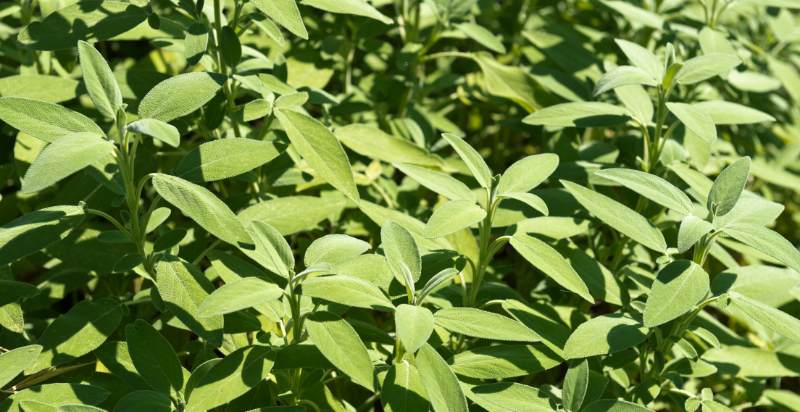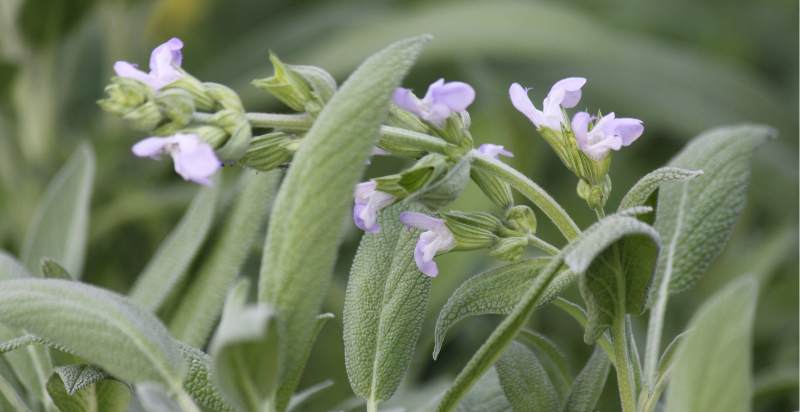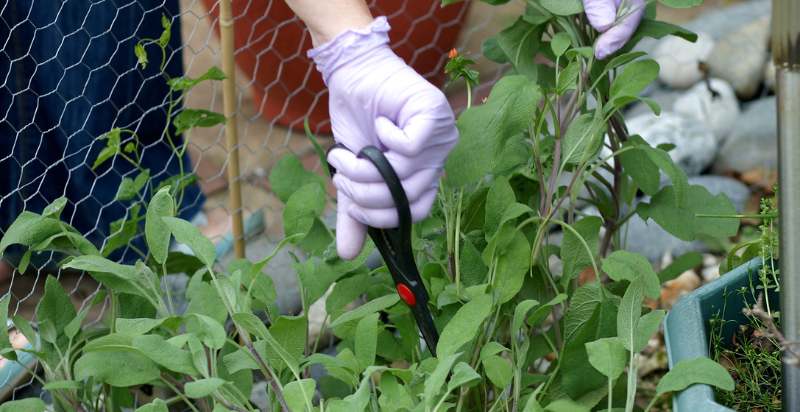The Sage plant is an evergreen perennial shrub native to the Mediterranean region and has been used as a medicinal plant for centuries. Its woody stems are covered in gray-green leaves with a slightly bitter taste. The flowers of the sage plant range from white to pink and purple, depending on the variety. Sage can also be found in many forms, including powder, liquid extracts, teas, oils, and ointments.
What is the Sage plant?
Sage is a member of the mint family and has a variety of species, all with slightly different characteristics. The scientific name for sage is Salvia officinalis, but many other names, including common sage and garden sage, also know it. It is an evergreen perennial shrub with woody stems that can reach up to two meters in height. The leaves of the plant are a gray-green color, have a slightly bitter taste, and, when crushed, smell very aromatic. Sage has been used for its medicinal properties since ancient times and is a powerful anti-inflammatory and antiseptic.
History of Sage plants:
Sage has been used for medicinal purposes since ancient times. It was traditionally used as an herbal remedy just like Ginger roots to treat various ailments ranging from colds and flu to digestive issues. In the middle ages, sage was believed to have magical properties, and it was often burned as incense or used in rituals. The herb is still widely used today, and it is used in a variety of dishes, teas, ointments, oils, and extracts.
Types of Sage plants:
There are several different varieties of sage, all with slightly different characteristics. The most common type is Salvia officinalis, which is the species used in traditional medicine and cooking. Other varieties include:
- White sage (Salvia apiana).
- Pineapple sage (Salvia elegans).
- Greek sage (Salvia fruticosa).
- Clary sage (Salvia sclarea).

Nutrition of Sage plants:
Sage is an excellent source of vitamins and minerals, as it contains several essential nutrients, including vitamin A, vitamin C, iron, and calcium. It also contains antioxidant compounds that can help reduce inflammation and protect cells from damage caused by free radicals. Sage is low in calories but high in fiber, making it a great choice for weight loss and digestive health.
Benefits of the Sage Plant:
Sage has numerous beneficial properties that make it extremely popular among health enthusiasts. Here are just some of its main benefits:
- Antioxidant Properties – Sage contains phenolic acids and flavonoids, which act as natural antioxidants. These antioxidants can help to protect the body from cellular damage caused by free radicals, helping to reduce the risk of chronic illnesses such as cancer, diabetes, and heart disease.
- Antimicrobial Properties – Sage has antimicrobial properties that can help to fight infections. It is effective against bacteria and fungi, which can cause gastrointestinal upset or other harmful infections in humans and animals.
- Digestive Health – Sage is a natural digestive aid due to its carminative action, which helps to reduce indigestion, bloating, gas and cramps. It also helps to stimulate gastric juices and bile production, aiding digestion and improving overall gut health.
- Stress Relief – Sage is known for its calming and relaxing effects, making it an excellent choice for people who suffer from stress or anxiety. The herb has been used as a natural remedy to treat insomnia, headaches, and other stress-related conditions.
- Bone Health – Sage is high in calcium, making it an effective natural remedy for improving bone health and preventing osteoporosis. It also helps to increase the absorption of dietary minerals such as magnesium and zinc, essential for maintaining strong bones.
How to Plant Sage plant?
Planting sage is an easy process. You will need a pot or container with drainage holes, a soil mix suitable for growing herbs, and sage cuttings or seeds.
- Begin by filling the pot or container with your soil mix to within 2 inches of the rim. If you use larger pots, add some gravel at the bottom before adding the soil mix to ensure proper drainage.
- If planting sage plants from cuttings, make sure that there is at least one leaf node on each cutting, and then place it in the center of your container and backfill around it with more soil mix until it’s firmly planted in the pot.
- Sage can be easily grown from seeds as well. Place the seed in a shallow container filled with soil and water it regularly to keep it moist. Once the seeds have germinated, transfer them into your pot or container with soil mix, leaving about an inch of space between each sage plant for adequate growth.
- Sage thrives best when planted in an area with full sun and good drainage. If you’re planting sage outdoors, pick a location away from strong winds so the delicate leaves won’t get damaged.
- Water your newly planted sage plants often to ensure they stay hydrated during the first few weeks of establishment. After this period, reduce watering frequency but never let the soil dry out completely.
- 6Sage is an easy herb to care for and will thrive with minimal effort. Prune any dead or dying leaves regularly and harvest when necessary by snipping off the top leaves of each plant. This will help promote new growth in your sage plants.
Following these steps, you should have a thriving sage garden in no time! Enjoy your fresh herbs!

How to Care for Sage Plants:
- Sage plants need minimal maintenance and care to thrive but require sunlight and regular watering. Ensure your sage is planted in an area that receives at least six hours of direct sun daily which is similar to other herbs such as marjoram, thyme, basil.
- Watering frequency will depend on the climate you live in and the type of soil you’re using; however, generally, sage prefers moist but not soggy soils. Check the soil moisture levels periodically with your finger; water when it feels slightly dry, about 1 inch below the surface.
- Feeding your sage plants once a month can help them to grow healthy and strong leaves that are great for harvesting. Use either liquid fertilizer or slow-release granules suitable for herbs and vegetables.
- Pruning your sage plants can help maintain their shape and size and encourage new growth. Remove any dead, damaged, or diseased branches as soon as possible to prevent the spread of the disease. Avoid pruning before flowering so that it can produce mature seeds.
- Sage is a perennial herb that will come back year after year if cared for properly. However, in some regions with harsher winters, you may need to bring the plant indoors during cold weather or cover it with mulch for extra protection from frost damage.
Caring for your sage plant does not have to be difficult! You can have a thriving and healthy sage garden in no time with just a few simple steps. Enjoy your fresh herbs!

Preventions from Pests and Diseases:
- One of the best ways to prevent pests and diseases from attacking your sage plants is by ensuring you’re planting in well-draining soil and a sunny location. Poor drainage or wet soils can create an ideal environment for fungal diseases, while shady spots attract certain insect pests.
- Practice crop rotation regularly and choose resistant varieties to reduce disease risk. To control pest populations, use natural methods such as spraying with neem oil or releasing ladybugs into your garden instead of using chemical pesticides, which may harm beneficial insects.
- Keeping the soil healthy and full of nutrients will also help prevent disease; adding compost or aged manure every couple of years helps maintain moisture levels and nutrient content in the soil.
- Inspect your sage plants regularly for signs of disease or pest infestations, and treat them immediately if necessary. Prune out any dead or damaged branches as soon as possible to stop the spread of infection.
Taking preventive measures is essential when caring for sage plants! Following these steps will help ensure that your sage stays healthy and pest-free so you can continue to enjoy its wonderful flavor.

How to Harvest Sage?
- The best time to harvest sage is in the morning when the leaves are still full of moisture and flavor. Snip off the top leaves of each plant with a pair of scissors or pruning shears.
- Harvest as much as needed for immediate use, or collect several sprigs if you plan to dry them for later use. You can also cut off entire branches if desired; make sure that some of the young growth at the base is left behind, so your sage plants continue to thrive.
- Rinse any harvested greens under cold water and dry them on paper towels before storing them in airtight containers.
Harvesting your sage plants will allow you to enjoy the fragrant and flavorful herb for months to come! Enjoy the fresh flavor of home-grown sage in your favorite recipes.
Good luck and happy harvesting!

How to Store Homegrown Sage?
- Once you’ve harvested your sage, it’s important to store it properly to preserve its flavor and shelf life. The best way to store homegrown sage is by drying or freezing it you can follow the same tips to dp this as with any other herbs such as dill , Tarragon .
- To dry the sage, tie a few sprigs together with twine and hang them upside down in a cool, dark area for about two weeks until completely dried out. You can also use an electric food dehydrator according to the manufacturer’s instructions.
- Once completely dry, crumble the leaves into small pieces and store them in airtight containers away from direct sunlight or heat sources such as ovens or hot water pipes. Alternatively, you can freeze your sage by layering the leaves between sheets of wax paper, then wrapping them in foil and freezing.
Storing your sage correctly will ensure that it retains its flavor and aroma for months to come! Enjoy your homegrown sage as an herb in delicious recipes or as a fragrant addition to potpourri.
How to Use Sage?
Sage is a versatile herb that can be used in many different recipes and for medicinal purposes. It’s often used to season meats, vegetables, sauces, soups, stuffing, marinades, and even desserts! Sage can also be brewed into tea to help relieve cold symptoms or aid digestion.
In addition to its culinary uses, sage has been used medicinally for centuries due to its antiseptic and anti-inflammatory properties. It’s known to help reduce the symptoms of coughs and colds as well as ease digestive issues such as indigestion and bloating.
So get creative with your homegrown sage! Enjoy the delicious flavor it adds to dishes or benefit from its medicinal properties.
Potential Risks From Sage Plant:
Sage plants are generally safe for cooking or medicinal purposes, but it’s important to be aware of potential risks. Consuming too much sage can have a powerful laxative effect and cause stomach upset, cramping and diarrhea, so it’s best to consume in moderation.
In addition, sage should not be consumed by pregnant women due to its stimulatory effects on the uterus, which could lead to miscarriage. Sage also contains thujone, which has been linked with convulsions and other neurological problems when consumed in large amounts; it is therefore advised that people with epilepsy avoid consuming large amounts of sage as well.
By following these guidelines, you can enjoy homegrown sage’s benefits without risking any potential side effects. Enjoy!
Conclusion:
Harvesting homegrown sage is a great way to enjoy the delicious flavor of this versatile herb for months to come. Use scissors or pruning shears to snip off the top leaves of each plant, rinse under cold water, and air dry before storing them in airtight containers or by freezing or drying them. Be aware of the potential risks – such as consuming too much sage or using it during pregnancy – so you can benefit from all its culinary and medicinal properties without danger. Enjoy your homegrown sage!
Good luck and happy harvesting!
- Water Berries: Description, Flavor, Benefits, And Uses - June 18, 2024
- Everything You Wanted To Know About Sweetheart Cherries - June 17, 2024
- Indian Jujube: Description, Flavor, Benefits, And Uses - April 30, 2024

8 thoughts on “What Is Sage? Planting, Growing and Using the Sage Herb. ”
Comments are closed.